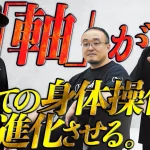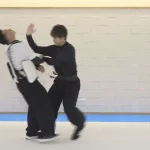Remembering Chiba Tsugutaka Shihan [Daito-ryu of Shikoku #4]

Olivier Gaurin, Chiba Sensei, and me in Wakimachi after a seminar.
As a young boy with a passion for Japanese culture and budo, my head was filled with dreams about what people referred to in a rather cliched way as “the land of the rising sun”. One of those tropes was that in Japan there existed some old masters who lived ascetic lifestyles in remote locations, and that if you could become their pupil, you would be able to learn from them the arcane of combat. As I got older and better informed, I became more realistic in my expectations. I also came to terms with the fact that I belonged to a late generation of practitioners, and that most direct students of Takeda Sokaku and Ueshiba Morihei were long gone. With them, so was a certain aspect of Japanese mind and culture, and what I experienced when I eventually joined several dojo in Japan was not at all unlike what I had seen in many other places that I had visited in the West. As life would have it though, and against all odds, I would eventually become the student of an old master, and it would take quite a bit of time and effort to get to him. During that special time, I learned as much about Daito-ryu as I learned about Japan itself.
My experience with Chiba Sensei
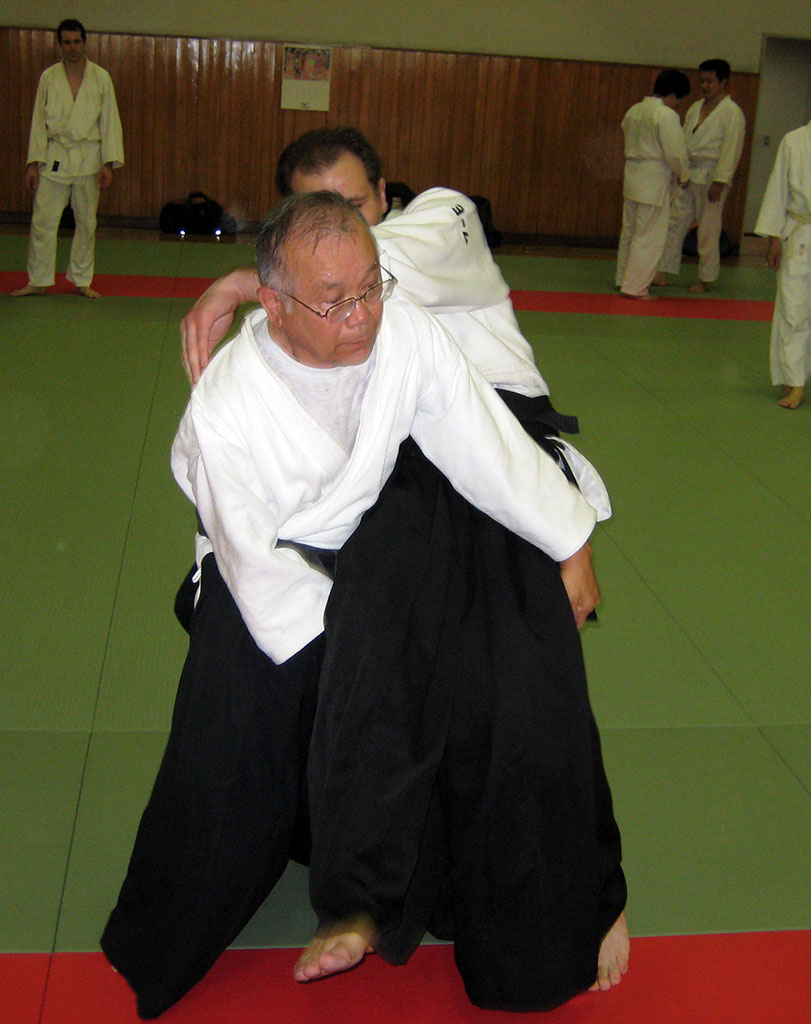
Me taking ukemi for Kobayashi Kiyohiro Sensei during a seminar in Tokyo (2008)
I was introduced to my first Daito-ryu aiki-jujutsu teacher, Kobayashi Kiyohiro Sensei, by Frenchman and long time Tokyo resident, Olivier Gaurin. Kobayashi Sensei is an 8th dan kyoju dairi student of Hisa Takuma. He is also the Manager of the Takumakai. I was so impressed by what Kobayashi Sensei was showing that I registered on the spot as his student.
Olivier became my de facto sempai there and after a few months, when he saw my sincere interest in the art of Daito-ryu, he told me that he would recommend me to someone who was even senior to Kobayashi Sensei. He took me to the island of Shikoku and introduced me to Chiba Tsugutaka Shihan. Chiba Sensei used to give seminars twice per year and according to Olivier, it was the place where all Kansai’s top instructors Daito-ryu went to learn.
As soon as we landed, we were invited to meet the 80-year-old master in his house. There I found out that as the head priest of the Joko-ji temple in Ikeda, he was in the most literal sense an old master who lived in a temple at the top of a remote mountain!
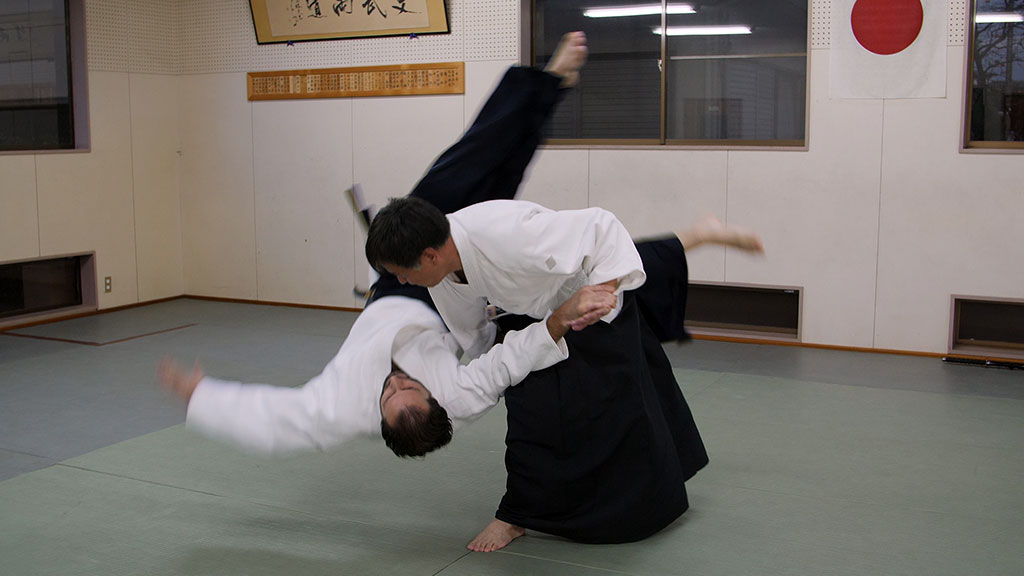
Sato Hideaki throwing me (Daito-ryu Shikoku Hombu Dojo, 2021).
Just like when I met Kobayashi Sensei, Chiba Sensei’s Daito-ryu was a revolution, and it deeply affected my understanding of aiki. However, due to my youth and lack of experience, his seminars were very difficult to understand, but I knew that each of them was truly a masterclass in the art. Chiba Sensei would demonstrate techniques in quick succession, providing each time a wealth of details, both by demonstration and through explanations. It was all very difficult to follow and I quickly realized that I was out of my depth. Luckily, I was able to count on the support of Olivier, as well as that of Sato Hideaki Sensei, who became the successor of Chiba Sensei as the head of Daito-ryu in Shikoku when he passed away in 2017.
Another shock for me, in addition to the high technical level, was the duration of those seminars, totaling between five or six hours of practice per day. The lack of real warm up, and the relative severity of the joint locks and pins were quite unpleasant. My back would hurt and my wrists were always red and swollen when I got home. Due to the very specific way in which Chiba Sensei instructed us to place our fingers, I would also develop long lasting cramps in my wrists that would keep me awake at night. I must say that for the first few years, I really did not enjoy going to those seminars, and it is Olivier’s insistence, plus the fact that I felt that there was something very rare and precious there to be learnt, that made me go.

Olivier Gaurin and Chiba Tsugutaka at Chiba Sensei’s home (2014).
Travelling from Honshu to Shikoku on a regular basis is indeed quite a task. I think Olivier and I tried pretty much everything, from renting a car, taking the train, the bus, and the plane, but it never took less than four hours to get to Wakimachi. Needless to say that there were just a handful of us travelling from Tokyo every time. This number steadily declined as the years went by until it was just Olivier and I. We also started to visit Chiba Sensei regularly between seminars. Few of us became the students of Chiba Sensei, but then of course, few of us made the trips to Shikoku as often as it took. None did so as often as Olivier.
The close relationship that Olivier and Chiba Sensei developed over the years is what allowed me and others to get access to this hidden treasure of budo. To get back to this image of the inaccessible master up in his mountain, I think that more than any other factor, one’s ability to learn really depends not only on how far you are willing to travel, but how often are you going to commit to that.
Time is of the essence
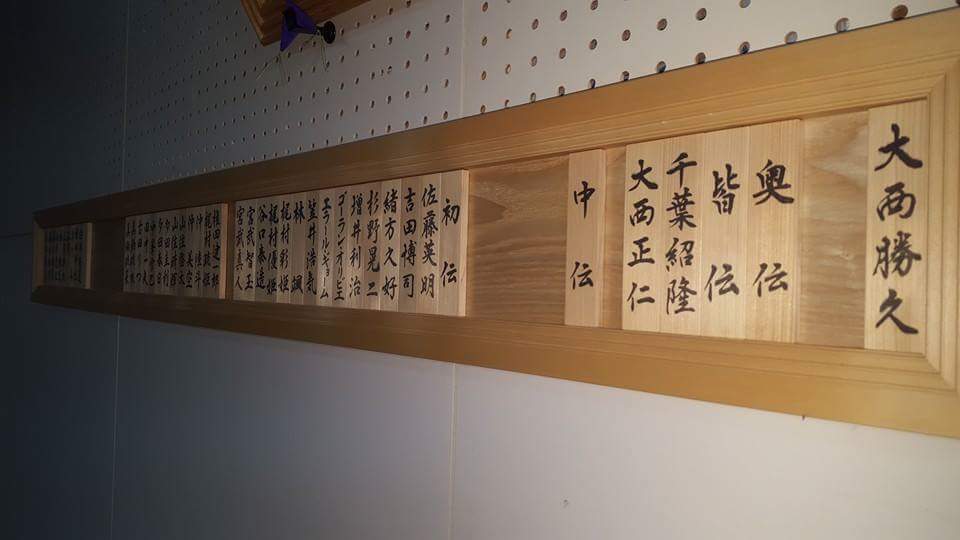
Nafudakake of the Shikoku Hombu.
Another thing that might strike non-Japanese practitioners is that in spite of the investment of energy, time and money I made in those trips, Chiba Sensei did not talk to me much, nor did he correct me on anything for the first few years. Although I never felt unwelcome during the seminars, I did feel distinctly isolated. People abroad often think that it is difficult to integrate Japanese society but in reality, it is not that which is hard. Japanese people are actually very kind and welcoming, and I have very rarely been refused entrance anywhere. However, once you have been let in, this is where the real difficulty starts since you are expected to learn to behave appropriately, and to fulfil a number of obligations. Only then, are you really becoming a part of one of the several concentric circles that form any Japanese group. So little by little, I built interactions and friendships with some students there, and Sato Sensei took it upon himself to take care of me in terms of making sure that I did come home every time with some substantial piece of information. It all became quite normal to me until one day, I entered the dojo and saw that my name was written on the nafudakake.

Chiba taught constantly, always in a good mood and even without exacting formalities
From that point on, Chiba Sensei started to instruct and correct me. Eventually, I was also lucky to receive some private instruction from him, especially regarding which elements of his Daito-ryu he would allow me to teach during my aikido seminars in Europe. When I tell this story to my French friends, they often react by saying “How do you feel about wasting those three years?”, to which I answer that those three years were not wasted, on the contrary. They were necessary for me to reach the necessary maturity to handle responsibly the knowledge that I would receive later.
Another thing that happened following my registration as monjin is that Chiba Sensei started to explain techniques quite differently compared to the way I was used to. This confused me a great deal and when I asked Olivier about the reasons behind that inconsistency, he replied to me: “You are now his student, so he is showing you the real way to do things.” In addition to that, I believe that there is also the fact that just like Takeda Sokaku and Nakatsu Heizaburo, Chiba tailored his teaching to each of his students, and to some extent, the things that he showed me were the things that he thought I could do best according to my personality and morphology.
Learning from an old man
There is an interesting trend in Daito-ryu where the teacher is often quite old compared to students. When he started instructing the Asahi group, Takeda Sokaku was about 77 years old, which at the time, was a rather advanced age. Takeda Tokimune was only 27 years old when his father died. While Nakatsu Heizaburo was only in his late fifties when Chiba Sensei started to learn from him, he had suffered a stroke, which had left him partially paralyzed. Similarly, senior Takumakai students such as Kobayashi Kiyohiro started learning from Hisa when he was well into his 70s, and after he too had a stroke. I myself was 30 years old when I met Chiba Sensei, and he was 80. I cannot but wonder if this had an influence on the way this particular line of Daito-ryu practices the techniques.
Daito-ryu being peculiar in not using unnecessary strength or athletic abilities (as opposed to a great deal of modern aikido), learning from an old and/or crippled man could actually have been an advantage. Unlike in aikido, the movement on the tatami is quite limited in space, and students have to deal very early on with a great level of technical details. Most of the first months or even years are spent practicing idori seated techniques, so there is no room for dynamic practice, randori, and intense breakfall until much later.
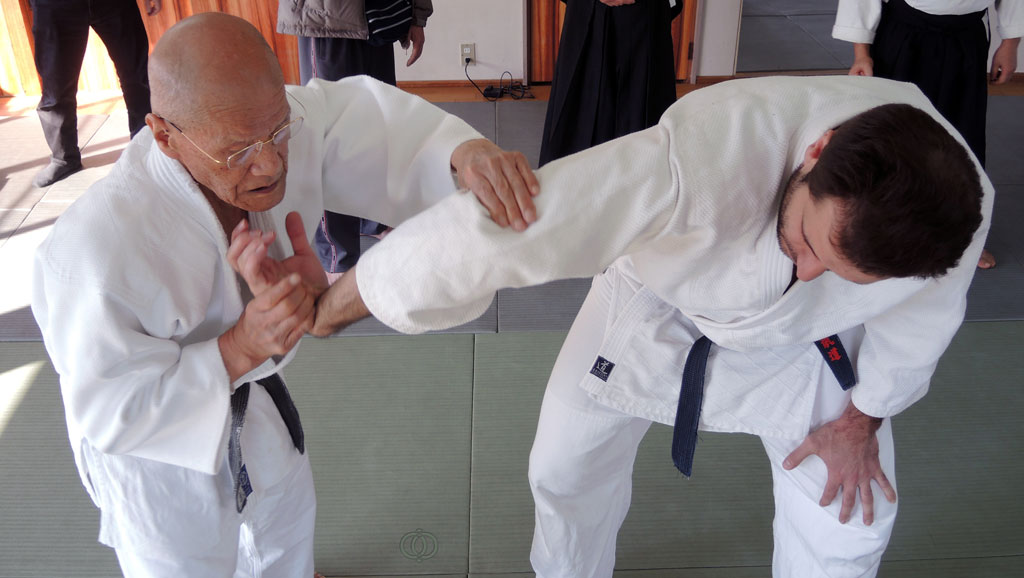
Chiba Sensei teaching me during a private class
Students are often left to work in pairs for extended periods of time. When the teacher demonstrates, it is usually for a very short time so one has to pay a great deal of attention, and have considerable memorization skills to retain most of the details. Having been previously taught by much younger and more dynamic aikido instructors, I was used to trying to replicate directly what they showed. Here however, some work of interpretation was needed, and it took me a long time to differentiate what was a truly important point, from what was just due to old age. Sometimes, my inability to distinguish between the two effectively led to some misunderstanding. For instance, I used to be puzzled by the way Chiba Sensei used to perform ippondori. I always thought that he was losing his balance due to having bad knees. Only later did I realize that he was in fact purposefully using his entire body weight, through that imbalance, to control his opponent which was actually a point for this technique. What I considered an imperfection for so long was actually an essential aspect of his technique! This became evident when Chiba Sensei did it on me.
This, I think, is a specificity of Daito-ryu. Students have to be incredibly focused in order to develop their perception of what makes a technique function, and they must be taught personally.
Create your own learning tools
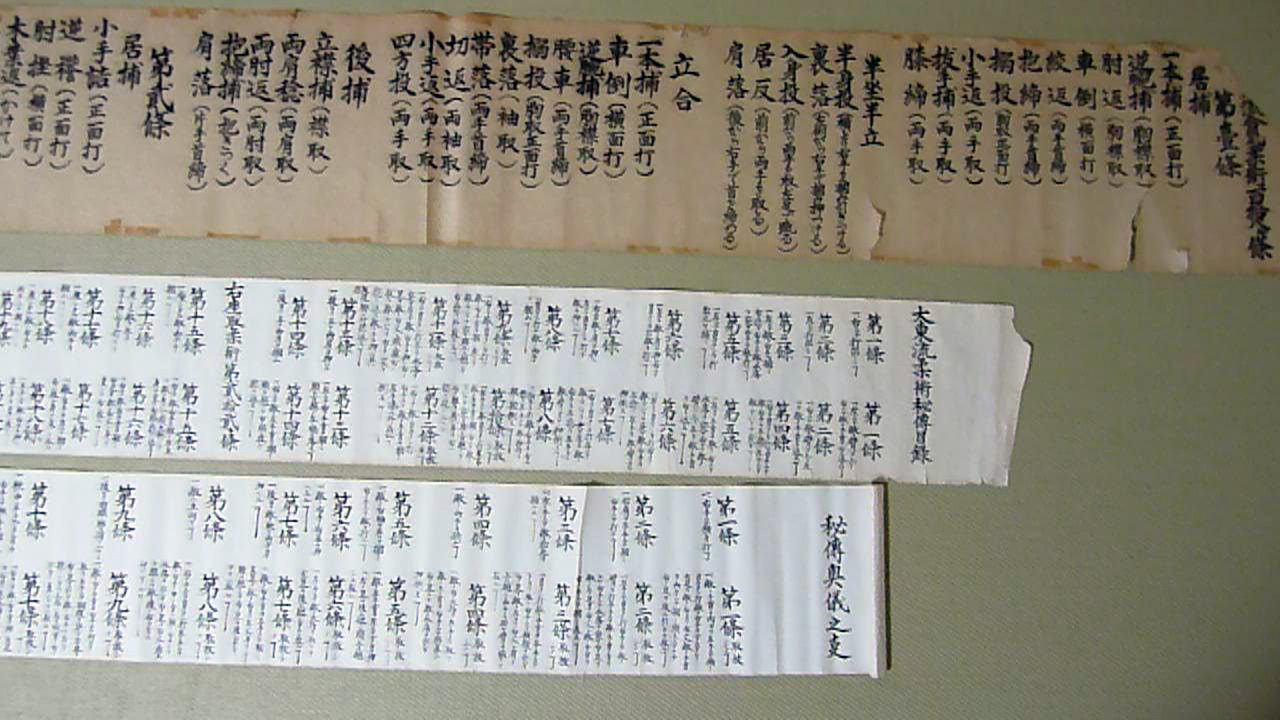
Chiba Sensei’s scrolls.
Similarly, unlike in aikido, Chiba Sensei’s school did not, until quite recently, provide any detailed instructional manual on how to perform the techniques, so students were expected to remember and take notes by themselves. Only after they had demonstrated that they had acquired the knowledge of a particular level, were students given the scroll, notes, or even pictures as a memory aid.
It was certainly the same for me and I spent a great deal of time organizing my notes, pictures, and videos, in order to consolidate my understanding. This tradition continues in our school and we only give instructional materials to the students only after they have demonstrated some levels of proficiency.
“What the mokuroku really is is a sort of reminder of the techniques you have already learned. If you simply copy sentences like “strike from the right, return from the right”, you won’t know what they mean. This is is my own interpretation, but I think that makimono is written in such a way that you can never do it right by just following what is written there. Sometimes it says the opposite of what you are supposed to do, and sometimes the truth.”
Chiba Tsugutaka

A page of the Daito-ryu aiki-jujutsu densho that we created for foreign students.
Interestingly, Olivier and I had to gently challenge this way of doing things after we were asked by Chiba Sensei to teach students abroad. We argued that the learning needs of students outside Japan would have to be addressed in a way that was different to that of the Japanese. To this effect, we produced the very first set of instructional material of that school.
Another thing that I realized is that I would probably belong to the very last generation of Chiba Sensei,’s students, so I started to think about a way to preserve his teachings and let people know about the history of his line. Keep in mind that at the time, virtually no one had heard of Chiba Sensei outside of Japan, let alone study with him. Chiba Sensei eventually accepted that we conduct an interview with him to go over his history and journey through budo. We went to his house one Saturday and shot a very long video, where he answered questions, with some additional clarifications from Sato Sensei. Chiba Sensei also brought us an incredible amount of old documents, scrolls, pictures, and notes.
A record for posterity
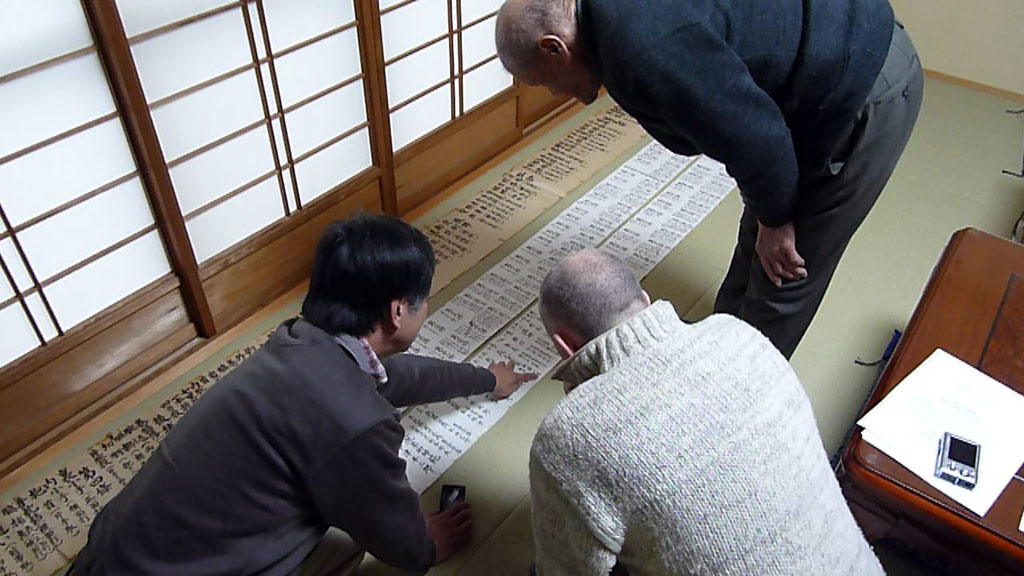
Chiba Sensei and Sato Sensei explaining the meaning of the scrolls to Olivier Gaurin.
I took note of everything and tried to copy as much as I could, even though at the time, I understood very little of what was presented to me. On the day we shot, Chiba Sensei’s passion for his art made him so volubulius that I am unable to remember how many hours we spent there. Chiba Sensei’s wife even came to offer us some homemade udon, typical of the region, so that we did not starve. The translation, editing, and study of those archives took Olivier and I more than a year but we were able to publish a series of videos of our conversation, which were very positively received abroad and considerably increased the awareness of practitioners about Daito-ryu, and more specifically about Chiba Sensei.
I can say that the making of those videos taught me almost as much as practice on the tatami. I am still going through this material today and finding new meaning, with the added hindsight provided by years of training and living in Japan. While in hindsight, these videos are far from perfect, I stand by them and by the positive impact they had. In fact, now that Chiba Sensei passed away, I consider them as invaluable windows into his life and wonderful character.
The meaning of grades and titles

Diploma given to me by Chiba Sensei, which bears the Takeda family crest.
A few years later, I was called to Shikoku and I received a certificate signed by Chiba Sensei. To my surprise, it said that I was now a sandan. I privately inquired to Sato Sensei, arguing that I was nowhere near that technical level, and Sato Sensei answered that there were far more criteria that sanctioned the awarding of a certificate, beside purely technical ones, and that I had fulfilled them through my dedication and the work I did for the art. He added that it was now my responsibility to ensure that I got to a point where technically, I felt worthy of the title.
This ignited a rocket under my bum and I worked harder than ever, increasing the frequency of the trips to Shikoku, so as to learn as much as possible during regular classes at the Shikoku Honbu under the guidance of Sato Sensei. Interestingly, this is not unusual in Japan, and I heard stories of people getting the equivalent grade from Tokimune Sensei, under the same conditions, but some never came back afterwards. Some used these grades for self-promotion in their own country, even though they are by definition void of meaning under Japanese system.
“Giving out makimono makes everyone happy, but you need to go through the actual learning process before that, and the important thing is to learn the technique.”
Chiba Tsugutaka
Practicing like a child
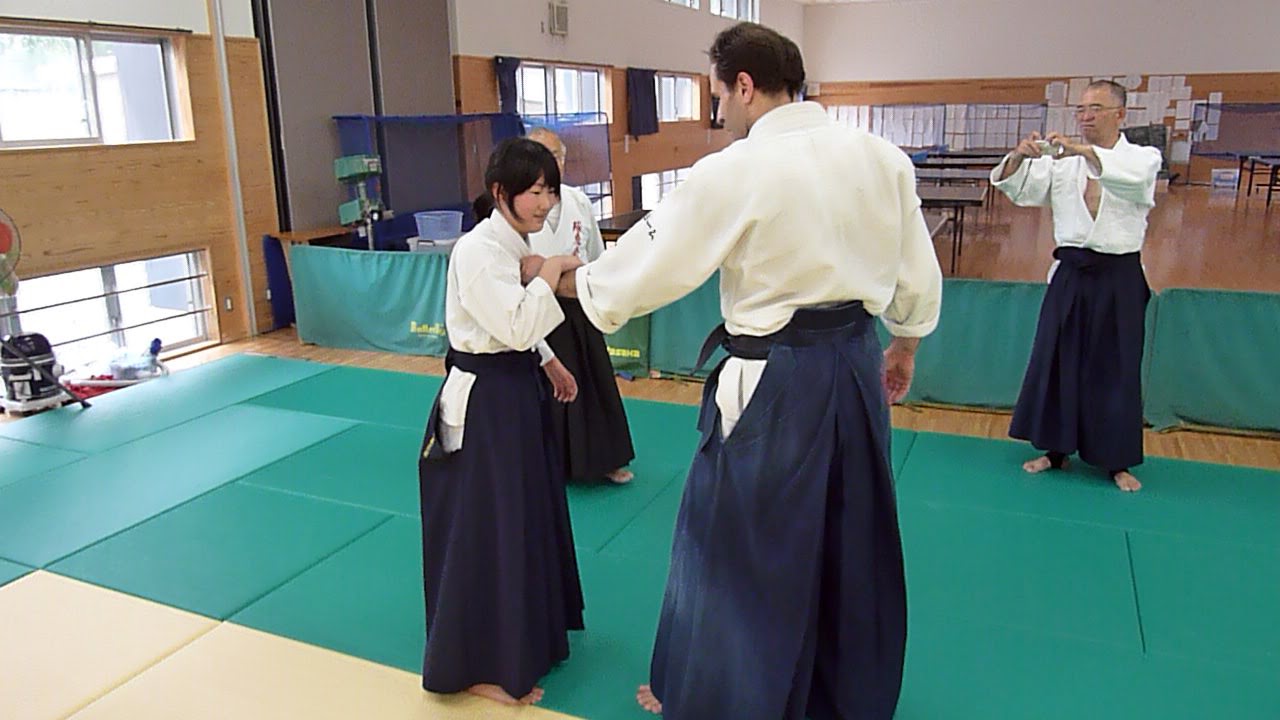
Children and adults practicing together. Here with Saki-Chan, this “little girl”, who impressed me so much by her efficiency.
Given the relative isolation of Wakimachi, at the time, most of the students in Sato Sensei’s classes were children. I initially felt disappointed not to be able to train with more adults, until one day when he paired me up with one of his female students, who might have been in middle school at the time. She was half my age and size, and yet, when she pinned me, I felt for the first time that I was truly stuck. This is the very first time that I realized that the claim of aiki, that a small person can subdue a larger one, was actually true, that it could be done. I humbly thanked her and my ego now deflated, I was able to learn a lot during those classes.
The teaching style was also different. In Shikoku, practice doesn’t start and stop as we step on or off the tatami. The entirety of the time is dedicated to Daito-ryu, whether it is in the morning before classes or seminars, during meals, or even at the bath house. At all times, I observed Chiba Sensei intensely, especially because I did not understand him well, and also, as I explained before, because he didn’t instruct me for the first few years. I particularly focused on the way he walked, the way he held his chopsticks or opened doors, and one day it clicked and this is how I understood how he did ippondori.

Chiba Sensei with Sato Sensei, making use of every moment to pass on Daito-ryu.
Interestingly, although Chiba Sensei was well into his eighties, he sometimes made a point of sleeping at the dojo with us during seminars, and he would always teach informally during the off times or at dinner. I remember vividly one day when he started lecturing me in the bath house’s changing room, while everyone else was already enjoying the warm water, about the fact that chokes techniques had to be adapted when your enemy was wet and that you couldn’t grab his clothes! I learned later that Nakatsu Sensei often took Takeda Sokaku to the bath and I cannot help wondering whether those were techniques that Takeda Sensei might have shown Nakatsu during those times. In hindsight, by staying with us, I think that Chiba was allowing us a sort of closer look into himself, not unlike what happened in the old uchi deshi system.
The path ahead
Chiba Sensei passed away at the age of 86, leaving Sato Hideaki Sensei in charge of running the Shikoku Hombu Dojo in Wakimachi. This really caused me to reflect upon the line I was a part of, and my place in it. As I said earlier, in Japan, being part of a group is mainly defined by your ability to fulfil the expectations associated with it. In that sense, titles, scrolls, and responsibilities do not carry a sense of satisfaction, but more that of an obligation.
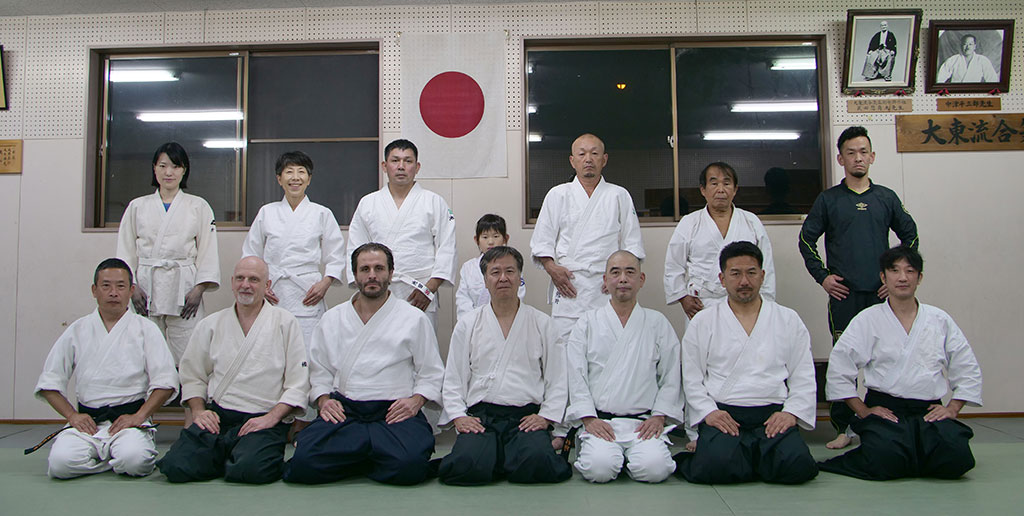
Tuesday night class with Sato Hideaki Sensei at the Shikoku Hombu (2020).
It feels quite scary now to know that we won’t be able to ask Chiba Sensei for advice on whether we are in the right tracks or not, both technically, and as an organization, especially now that we have opened several branches overseas. Indeed, Chiba Sensei gave Olivier and I the task of teaching his Daito-ryu abroad.
“You two, Guillaume and Olivier, are so enthusiastic about Daito-ryu that you have started teaching it from France and spread it to European countries. It’s not a snapshot, but a living thing, I want you to actually touch it, practice it, and inherit it.”
Chiba Tsugutaka
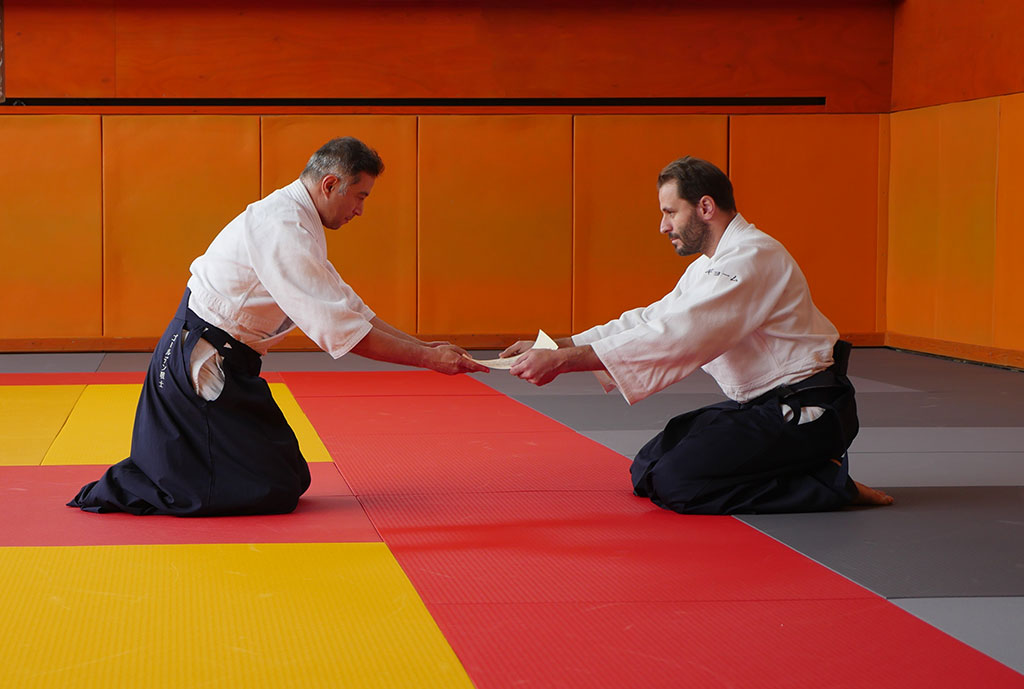
Me awarding a Daito-ryu Shikoku Hombu certificate to one of my students in France.
We have promoted our first generation of black belts and in due time, it will be their turn to pass on the flame to others. I hope that until then, we will be able to successfully teach the technique to this new generation of instructors, and as importantly, the linguistic, cultural and ethical aspects that Chiba Sensei passed on to us. This will definitely require some careful thinking about pedagogical strategies, with some unavoidable adaptations and changes.
I am sure that Sato Sensei is thinking very carefully about this. Chiba Sensei told us once that we have to become like a branch and seek our original trunk in order to become stronger. All we can say is that we stem from that particular trunk, and the only true question is whether we are a thin or a thick branch. The more the branches grow, the better, because then, the more the trunk grows with them, and as the trunk grows, so do the branches.
Now our responsibility, as students, will be to learn as much as we can from him to ensure that this line, one of many others in Daito-ryu, continues with its specificities and its substance.
“Every teacher is a truth in himself. The real question is: How competent was that teacher’s own sensei. Everything stems from that.”
Chiba Tsugutaka
About the author

Guillaume Erard
Guillaume Erard is an author and educator, permanent resident of Japan. He has been training for over ten years at the Aikikai Headquarters in Tokyo, where he received the 6th Dan from Aikido Doshu Moriteru Ueshiba. He studied with some of the world’s leading Aikido instructors, including several direct students of O Sensei, and has produced a number of well regarded video interviews with them. Guillaume now heads the Yokohama AikiDojo and he regularly travels back to Europe to give lectures and seminars. Guillaume also holds the title of 5th Dan in Daito-ryu aiki-jujutsu and serves as Deputy Secretary for International Affairs of the Shikoku Headquarters. He is passionate about science and education, and he holds a PhD in Molecular Biology. Guillaume’s work can be accessed through his website and on his YouTube channel.





